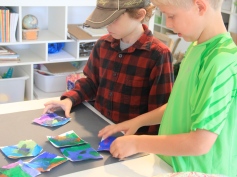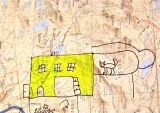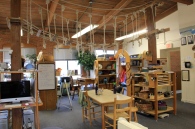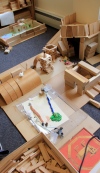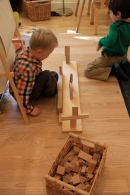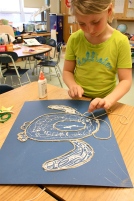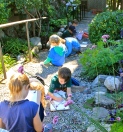“Participation that is personal experience, or creative work, is the sole and most real conviction.” ~ Max Weber, Essays on Art
It’s just a short time before kids step into our classrooms. As their teachers, we are cooking up new ways to combine curricular elements, in particular making art central to our programs. Why? Research tells us that an integrated curriculum that has meaning for children leads to deeper thinking and a high level of student engagement. Children to whom we give a rich array of materials and extended time to delve into long term projects will thrive as problem-solvers, makers, and doers, oftentimes beyond school.
 This blog focuses on 6 educators who work with varied age groups and communities. Each teacher has many extraordinary skills. All are passionate about their work and think innovatively about how students learn.
This blog focuses on 6 educators who work with varied age groups and communities. Each teacher has many extraordinary skills. All are passionate about their work and think innovatively about how students learn.
Building on a key skill for each one, I’ve created a list of 6 critical elements to connect art to classroom learning. Put them in your backpack, take them with you to school, try them out:
1.BUILD CURRICULAR CONNECTIONS
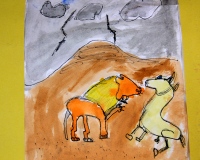 Teresa Baker, Fourth Grade Teacher [Charles River School, MA]
Teresa Baker, Fourth Grade Teacher [Charles River School, MA]
Teresa Baker believes that children learn best when they cross boundaries between subject areas. Interweaving art, literacy, math, social science, and music into her program, Ms. Baker trains her students to look for patterns and connect their ideas. In the process of studying cultures and civilizations (their first long term investigation is Ancient Greece) they take on the identities of gods and goddesses, 
become archeologists, mapmakers, designers, and 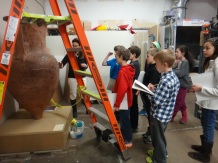 composers. As they learn skills, they make art, which fills their classroom, giving visitors the impression they’ve entered a museum. Students who are being grounded in history, are simultaneously launching themselves into a future as great connectors and creators – young people who can and will make theirs a more positive world.
composers. As they learn skills, they make art, which fills their classroom, giving visitors the impression they’ve entered a museum. Students who are being grounded in history, are simultaneously launching themselves into a future as great connectors and creators – young people who can and will make theirs a more positive world.
2.MAKE MATERIALS MEMORABLE
Rikki Gallagher, Elementary School Art Teacher [Waynflete School, ME]
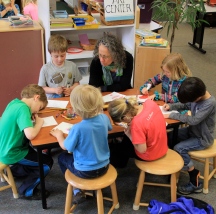
 My visits with Rikki opened my eyes to the myriad of extraordinary possibilities in art education. Rikki transforms a small space, whether it is a nook in a classroom or her own art room, into a studio for the exploration of novel ideas.
My visits with Rikki opened my eyes to the myriad of extraordinary possibilities in art education. Rikki transforms a small space, whether it is a nook in a classroom or her own art room, into a studio for the exploration of novel ideas. 
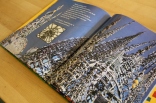 Beyond her passion and presence, she inspires children with materials and a classroom stocked with books about art and artists. I saw children building their own Watts Towers and crafting wooden sculptures in line with Louise Nevelson’s work. In tight spaces students work small but think big. Rikki’s kids are confident and even daring – not unlike Rikki herself.
Beyond her passion and presence, she inspires children with materials and a classroom stocked with books about art and artists. I saw children building their own Watts Towers and crafting wooden sculptures in line with Louise Nevelson’s work. In tight spaces students work small but think big. Rikki’s kids are confident and even daring – not unlike Rikki herself.
3.CALL FOR COLLABORATION
Alexis Iammarino, Teaching Artist [LEAPS of IMAGINATION, Center for Maine Contemporary Art, Watershed School, Wayfinder School, Steel House, ME]

 Alexis is Lead Artist for LEAPS of IMAGINATION and has brought an innate belief in collaboration to the teaching team and to the students with whom we work. The program, supported by the Center for Maine Contemporary Art, brings mentor artists and classroom teachers together, making decisions about program content and processes from the start. Giving young people the chance to dialogue about technique and receive feedback from their peers offers children opportunities to think deeply about their experience as young artists. LEAPS participants work in pairs or threesomes. Kids tell us that learning from others goes a long way, while certainly some say that there are hurtles to get over as individuals and teammates. Alexis facilitates the experience as a gentle yet spirited role model from whom we all learn.
Alexis is Lead Artist for LEAPS of IMAGINATION and has brought an innate belief in collaboration to the teaching team and to the students with whom we work. The program, supported by the Center for Maine Contemporary Art, brings mentor artists and classroom teachers together, making decisions about program content and processes from the start. Giving young people the chance to dialogue about technique and receive feedback from their peers offers children opportunities to think deeply about their experience as young artists. LEAPS participants work in pairs or threesomes. Kids tell us that learning from others goes a long way, while certainly some say that there are hurtles to get over as individuals and teammates. Alexis facilitates the experience as a gentle yet spirited role model from whom we all learn.
4.CULTIVATE A PROBLEM-SOLVING MINDSET
Arati Pandit, School Director [Cold Spring School, CT]
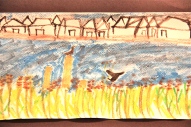 Cold Spring School drives children’s thinking through central themes, an abundance of materials, and the expectation that children will put their minds together to give form to theory. When teachers set up complex problems for children to solve, Cold Spring kids rise to the occasion. On last fall’s visit I saw work that required an extended time commitment. Kids had clearly tried out new ideas, had faced stumbling blocks, and ultimately created original concepts – an art form or piece of writing that revealed their personal perspective. That’s what students do at Cold Spring. As their school leader, Ms. Pandit is all about propelling deep thinking through art, embracing new programs as quickly as she can.
Cold Spring School drives children’s thinking through central themes, an abundance of materials, and the expectation that children will put their minds together to give form to theory. When teachers set up complex problems for children to solve, Cold Spring kids rise to the occasion. On last fall’s visit I saw work that required an extended time commitment. Kids had clearly tried out new ideas, had faced stumbling blocks, and ultimately created original concepts – an art form or piece of writing that revealed their personal perspective. That’s what students do at Cold Spring. As their school leader, Ms. Pandit is all about propelling deep thinking through art, embracing new programs as quickly as she can.
5. PROMOTE PROCESS LEARNING
Jessie Vogel, Associate Director [Harborlight Nursery School, MA]
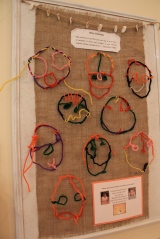
Jessie empowers students to believe in themselves as creators, communicators, and thinkers. Inviting them into some of their earliest school experiences, she teaches them that learning is a process – one that takes time, patience, and sometimes involves redoing. Jessie offers children every opportunity to give voice to their ideas. She helps them understand what the process might look like before it begins, and she documents it as it happens. If we know that art and process are intimately linked from a young age, we have a positive paradigm through which to make art happen as our lives unfold.
6.GET OUT TO LEARN
Sandy Weisman: Artist/Museum Educator [CMCA, LEAPS of IMAGINATION, 26 Split Rock Cove, ME]
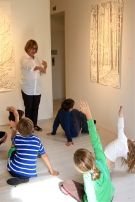
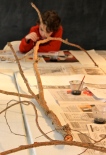
 Sandy Weisman has a long history as a museum educator, and she has launched an impressive program at the Center for Maine Contemporary Art. Bringing school children inside a gallery, she teaches them to look to learn before they dive into their own artwork. Their experiences of observing, hypothesizing, inferring, and ultimately creating are part of an array of interrelated activities. Getting kids out of their usual environment to explore new ways to see and make art exercises their brains, their limbs, and their imaginations.
Sandy Weisman has a long history as a museum educator, and she has launched an impressive program at the Center for Maine Contemporary Art. Bringing school children inside a gallery, she teaches them to look to learn before they dive into their own artwork. Their experiences of observing, hypothesizing, inferring, and ultimately creating are part of an array of interrelated activities. Getting kids out of their usual environment to explore new ways to see and make art exercises their brains, their limbs, and their imaginations.
Let 2015 be a year when art plays a significant role in your classroom program. Learn from these pros – bring the playfulness, invest the time, and invite the process of making art into your school.
